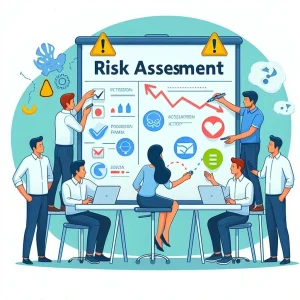The role of a contract compliance auditor is crucial in ensuring that all agreements are adhered to properly. This type of auditing is essential for mitigating risks, optimizing performance, and maintaining regulatory compliance. By systematically reviewing contracts and their execution, auditors can identify discrepancies, ensure that obligations are met, and safeguard the organization against potential legal and financial repercussions.
The role of contract compliance auditors is multifaceted. These professionals are responsible for evaluating the accuracy and completeness of contract documentation, assessing compliance with legal and regulatory requirements, and ensuring that all parties fulfill their contractual obligations. They play a vital role in enhancing transparency and accountability within the organization, as well as in fostering effective communication between stakeholders. By conducting thorough audits, they help organizations avoid costly mistakes and improve overall operational efficiency.
However, contract compliance auditing is not without its challenges. Internal auditors and compliance teams often encounter common pitfalls that can hinder the effectiveness of their audits. These pitfalls include inadequate documentation, inaccurate reporting, and a lack of regular auditing processes. In this blog post, we will explore these frequent errors in detail and provide strategies to avoid them, ensuring that your contract compliance auditing process is robust and effective. By addressing these issues, organizations can enhance their compliance efforts and ultimately achieve better outcomes in their contract management practices.
Understanding Contract Compliance Auditing
Contract compliance auditing is a critical process that ensures organizations adhere to the terms and conditions outlined in their contracts, as well as to relevant regulatory requirements. This section aims to provide internal auditors and compliance teams with a foundational understanding of the objectives, key components, and implications of non-compliance in contract compliance auditing.
Objectives of Contract Compliance Audits
The primary objectives of contract compliance audits include:
- Verification of Adherence: Ensuring that all parties involved in a contract are fulfilling their obligations as specified. This includes checking for compliance with the agreed-upon terms and conditions, which is essential for maintaining the integrity of the contractual relationship [3][4].
- Risk Mitigation: Identifying potential risks associated with non-compliance, such as financial penalties, legal repercussions, and damage to reputation. By conducting regular audits, organizations can proactively address issues before they escalate [1][6].
- Enhancing Operational Efficiency: Audits can uncover inefficiencies in contract management processes, allowing organizations to streamline operations and improve overall performance [9].
Key Components of Contract Compliance
Contract compliance auditing encompasses several key components that auditors must focus on:
- Adherence to Terms and Conditions: This involves a thorough review of the contract to ensure that all parties are meeting their obligations. Inaccuracies in documentation or failure to meet specific requirements can lead to significant issues, including invalid contracts [3][4].
- Regulatory Requirements: Organizations must comply with industry-specific regulations and legal standards. Auditors should verify that contracts reflect current laws and regulations, as non-compliance can result in severe penalties [1][5].
- Documentation Accuracy: Maintaining accurate and up-to-date documentation is crucial. Inadequate or outdated records can lead to misunderstandings and compliance failures, making it essential for auditors to ensure that all documentation is complete and correct [2][13].
Implications of Non-Compliance
The consequences of failing to comply with contract terms and regulatory requirements can be severe for organizations:
- Financial Losses: Non-compliance can lead to financial penalties, overbillings, and other costly errors that can significantly impact an organization’s bottom line [12][14].
- Legal Repercussions: Organizations may face lawsuits or other legal actions if they fail to adhere to contractual obligations or regulatory standards. This can result in not only financial costs but also damage to the organization’s reputation [10].
- Operational Disruptions: Non-compliance can disrupt business operations, leading to delays, increased costs, and strained relationships with vendors and partners. This can ultimately affect the organization’s ability to deliver products or services effectively [11].
Understanding the objectives, key components, and implications of contract compliance auditing is essential for internal auditors and compliance teams. By recognizing and addressing common pitfalls, organizations can enhance their compliance efforts and mitigate risks associated with contract management.
Common Pitfalls in Contract Compliance Auditing
Contract compliance auditing is a critical function within internal audit and compliance teams, ensuring that organizations adhere to legal and contractual obligations. However, several common pitfalls can hinder the effectiveness of these audits. Here, we identify and elaborate on frequent mistakes made during contract compliance audits and provide strategies to avoid them.
1. Lack of Clear Audit Objectives
One of the most significant pitfalls in contract compliance auditing is the absence of well-defined audit objectives. Vague goals can lead to inefficiencies, as auditors may not know what specific compliance areas to focus on. This lack of direction can result in incomplete audits, missed compliance issues, and wasted resources. To mitigate this risk, it is essential to establish clear, measurable objectives that align with organizational goals and regulatory requirements. This clarity will guide the audit process and ensure that all relevant compliance aspects are thoroughly examined [1][3].
2. Inadequate Documentation Review
Thorough documentation review is paramount in contract compliance auditing. Inadequate checks can lead to overlooking critical compliance issues, such as missing clauses or incorrect terms. This oversight can result in financial losses or legal complications. Auditors should implement a systematic approach to documentation review, ensuring that all contracts are examined for accuracy and completeness. Utilizing contract management systems can streamline this process, making it easier to track changes and ensure that all necessary documentation is in place [2][15].
3. Failure to Involve Relevant Stakeholders
Collaboration is key in contract compliance auditing. Failing to involve relevant stakeholders, such as legal and procurement teams, can lead to a lack of insight into compliance requirements and potential risks. Engaging these teams early in the audit process fosters a comprehensive understanding of the contracts and their implications. This collaboration can also facilitate the identification of compliance gaps and enhance the overall effectiveness of the audit [4][5].
4. Neglecting to Update Audit Procedures
Outdated audit procedures pose a significant risk to the effectiveness of contract compliance audits. As regulations and business environments evolve, it is crucial for audit practices to adapt accordingly. Neglecting to update procedures can result in non-compliance and missed opportunities for improvement. Regularly reviewing and revising audit methodologies ensures that they remain relevant and effective in addressing current compliance challenges. This adaptability is essential for maintaining a robust compliance framework [6][12].
5. Overlooking Data Analytics
In today’s data-driven environment, overlooking data analytics can severely limit the effectiveness of contract compliance audits. Data insights can reveal patterns and trends that may not be immediately apparent through traditional audit methods. By leveraging data analytics, auditors can enhance their ability to identify compliance issues, assess risks, and make informed decisions. Incorporating data analysis into the audit process not only improves efficiency but also strengthens the overall compliance posture of the organization [11].
By recognizing and addressing these common pitfalls, internal auditors and compliance teams can significantly enhance the effectiveness of contract compliance audits. Establishing clear objectives, conducting thorough documentation reviews, involving relevant stakeholders, updating audit procedures, and utilizing data analytics are all critical steps in ensuring successful compliance audits.
How to Avoid These Pitfalls
In the realm of contract compliance auditing, internal auditors and compliance teams often encounter various challenges that can hinder the effectiveness of their audits. By proactively addressing these common pitfalls, organizations can enhance their auditing processes and ensure compliance with contractual obligations. Here are some actionable strategies to consider:
- Set Clear and Measurable Audit Objectives: Establishing specific goals at the beginning of the audit process is crucial. Clear objectives help guide the audit team and provide a framework for evaluating success. This approach ensures that the audit aligns with the organization’s broader goals and compliance requirements, reducing the risk of oversight or misalignment with strategic priorities [2][10].
- Implement a Comprehensive Documentation Checklist: A thorough documentation checklist is essential for ensuring that all necessary information is reviewed during the audit. This checklist should include all relevant contracts, amendments, and compliance records. By maintaining consistent and complete documentation, auditors can avoid delays and potential audit failures due to missing or inconsistent records [11][14].
- Engage with Stakeholders Early in the Audit Process: Involving key stakeholders from the outset fosters collaboration and provides valuable insights that can enhance the audit’s effectiveness. Early engagement helps auditors understand the context of the contracts being reviewed and identify potential areas of concern, leading to a more comprehensive audit outcome [12][15].
- Regularly Update Audit Methodologies: The landscape of compliance and regulations is constantly evolving. Internal auditors should regularly review and update their audit methodologies to incorporate best practices and adapt to industry changes. This proactive approach ensures that audits remain relevant and effective in addressing current compliance challenges [4][5].
- Utilize Data Analytics Tools: Leveraging data analytics can significantly enhance the audit process. By using analytical tools, auditors can identify trends, anomalies, and areas that require further investigation. This data-driven approach allows for a more targeted audit, enabling teams to focus their efforts on high-risk areas and improve overall compliance outcomes [3][13].
By implementing these strategies, internal auditors and compliance teams can effectively navigate the common pitfalls associated with contract compliance auditing, ultimately leading to more successful and efficient audits.
Conclusion
In the realm of internal auditing, particularly in contract compliance auditing, it is crucial to recognize and avoid common pitfalls that can undermine the effectiveness of the audit process. By addressing these frequent errors, organizations can enhance their compliance efforts and mitigate risks associated with contractual obligations.
- Importance of Avoiding Common Pitfalls: Contract compliance audits are essential for ensuring that organizations adhere to legal, field-specific, and industry regulations. Common mistakes, such as inadequate documentation, inaccurate reporting, and failure to conduct regular audits, can lead to significant financial losses and legal complications. By being aware of these pitfalls, internal auditors can implement strategies to prevent them, thereby safeguarding the organization’s interests and maintaining compliance [1][6][14].
- Ongoing Training and Development: Continuous education and training for internal auditors are vital in keeping them updated on the latest compliance requirements and auditing techniques. This not only enhances their skills but also fosters a culture of accountability and diligence within the organization. Regular workshops, seminars, and access to updated resources can empower auditors to perform their roles more effectively and adapt to evolving regulatory landscapes [3][4].
- Reflection and Improvement: It is essential for internal auditors and compliance teams to regularly reflect on their current auditing practices. By conducting self-assessments and seeking feedback, teams can identify areas for improvement and implement best practices. This proactive approach not only enhances the quality of audits but also contributes to a more robust compliance framework within the organization [2][10].
In summary, by recognizing the common pitfalls in contract compliance auditing, investing in ongoing training, and fostering a culture of reflection and improvement, internal auditors can significantly enhance their effectiveness and contribute to the overall success of their organizations.
Find out more about Shaun Stoltz https://www.shaunstoltz.com/about/
This post was written by an AI and reviewed/edited by a human.



